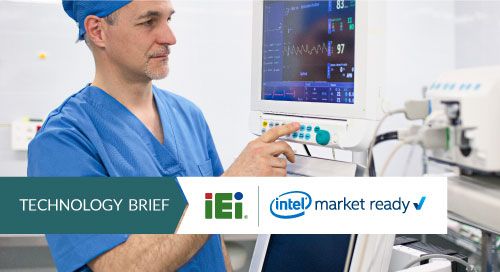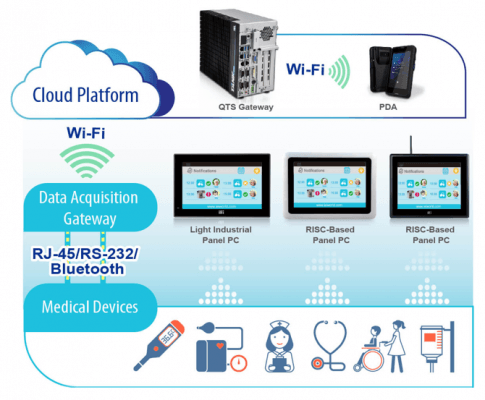Increase Patient Care, Decrease Errors with IoT

If patients can use a hospital’s wireless network to watch videos or play games on their smartphones, why aren’t more hospitals using their network to improve health outcomes? For example, connecting medical device data directly to a patient electronic medical record (EMR) in the cloud can streamline care and reduce errors.
Now, increasingly they are. And it’s not simply a matter of convenience. An investigation into health information technology-related sentinel events proved that the majority of errors were attributed to manual input (33%), workflow and communication (24%), and clinical content (23%).
Clearly there’s a need for technology to automate transfer of accurate medical device data to the patient’s EMR and, in the process, eliminate manual data entry that too often results in errors. Plus, with an increasingly aging population, patient fragility can compound the effect of even minor mistakes.
Connected medical devices provide physicians with accurate data, enabling them to correctly diagnose diseases, recommend proper procedures, and prescribe the right medications. In addition, it frees up caregivers, giving them more time to devote to their patients and improve the medical professional-patient relationship.
But in many countries, medical monitoring devices are not connected to healthcare systems. And patient records are not integrated or digitized, delaying treatment and increasing stress on staff and patients. Remarkably, there are still places where patients are responsible for their own records, bringing a folder stuffed with paper each time they visit a doctor. All of this shows there’s a keen opportunity for improvement.
IoT Innovations Are the Treatment
New IoT technologies provide hospitals and clinics an opportunity to replace paper or to augment EMRs—eliminating manual data entry. This means that accurate data collection, processing, and storage are automated—from the edge to the cloud—addressing many of the challenges healthcare facilities face, while providing three key outcomes:
- Modernized health information systems
- Prioritization of patient care
- Improved data accuracy
One such solution is the Integrative Data Acquisition System for Medical Care, developed by IEI Integration Corp. (Figure 1).

In describing the solution, David Hung, Medical Computing Product Manager at IEI, referred to it as having three layers. “In the first layer,” said Hung, “are the medical devices at the edge, which measure the patient’s vital signs.”
This is followed by the second layer, composed of gateways powered by Intel® processors. These gateways acquire data from medical devices using wired, Wi-Fi, or Bluetooth connectivity, and upload it to the cloud.
The cloud occupies the third layer, where the patient’s health record resides. There, the data can be analyzed for a health assessment and accessed by a clinician with a secure mobile device in the hospital room or from a remote location. The data can also be used for insurance, billing, and tracking potential epidemics such as avian flu—all while complying with data privacy laws.
Together these three layers form a solution that can be connected with a wide range of medical devices to provide hospital staff with more time to interact with patients and the benefit of accurate health records.
Motivating Deployments
The Joint Commission International (JCI) is the world leader in healthcare accreditation, and according to Hung, a JCI audit is one of the forces driving hospitals to deploy new technologies. “A hospital must earn its JCI accreditation every three years, which, among other things, enables it to receive higher payments from insurance companies,” said Hung. “Demonstrating accuracy of electronic health records is critical for accreditation.”
“Caregivers can now spend more time with their patients and less time working on paper records or at their computers,” said Hung. This matters in two important ways: Patients experience increased satisfaction with their healthcare provider, and positive patient attitudes can help alleviate illness.
Other deployment objectives include using IT to normalize caregiver standard operating procedures, reduce risk, and lower the amount of work required by clinicians and other personnel as well as to enhance employee satisfaction.
The solution also improves workflow in hospitals and specialty clinics, such as hemodialysis centers. In this example, a clinician must record the weight of a dialysis patient before and after each treatment. “Automated transmission from medical devices simplifies the process and increases the accuracy of EMR data,” said Hung. Hemodialysis clinicians will also receive an automatic alert if the patient’s weight after dialysis is not in the acceptable range, enhancing the safety of such treatments.
Hung further explained that by using international standard frameworks such as HL7, the solution is interoperable across different platforms and can work with multiple device providers. This allows healthcare organizations to select the equipment and IoT devices that best fit their needs and budget.
The scalable solution also supports multiple languages, making it simple to deploy in hospitals and clinics in any country. “We’ve deployed our solution in many hospitals,” said Hung, “including Taiwan’s largest, Chang Gung Memorial. Each hospital may have very different needs and our ability to connect a wide range of smart IoT medical devices provides the flexibility they need.”
State-of-the-art technologies are enabling more and more healthcare organizations to deploy customized solutions–demonstrating how IoT can enhance the quality of patient care.